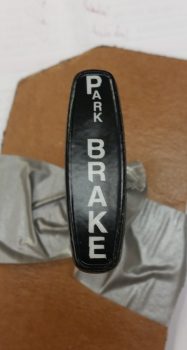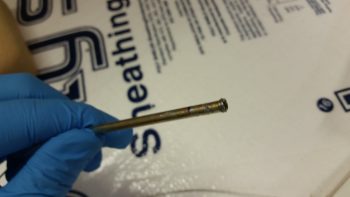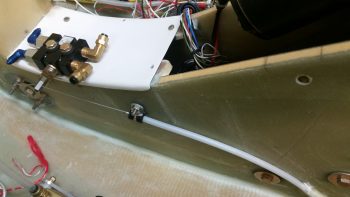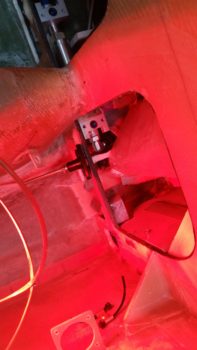Chapter 9 — Nose Brake Components
This page covers the brake system components that are located in the nose area of the aircraft. [NOTE: A good majority of the actual nose located brake lines are covered in Chapter 13, since the brake lines are mostly embedded].
4 December 2015 — While making up a bunch of K1000-3 nutplate assemblies for some nose components, I also made up a double K1000-3 nutplate assembly for the Matco parking brake.
Here’s a side shot of the parking brake nutplate assembly with AN3-11A bolts installed.
•••
6 December 2015 — Today I started off by doing some research as I watched some football. The first thing I had on my list to figure out was the exact configuration of my brake line components. I did some poking around on the Matco website to figure out what components go where for my brake system. I found the information I was looking for and was able to tailor it to the brake system components I have on hand.
Again, being a true Neanderthal and PowerPoint Ranger, I jimmied up a quick PowerPoint slide to display what was going on with the brake system. One reason I was checking out my brake system is because I wanted to confirm what goes where in the nose so I can plan better as I build the NG30 aft cover and the nose side walls.
•••
15 December 2015 — I mocked up my parking brake to get an idea of how my brake components will be mounted in the nose area. As an aside, I’ve nailed down my brake line configuration so that I now know every item from A-to-Z on my brake system, including every piece, type & thickness of tubing down to every fitting. I’ll go more into that later in another post.
NOTE – Here’s the updated brake line system diagram:
•••
21 December 2015 — I spent the latter part of the evening working on my brake lines in the forward NG30 nose area. I cleaned up the inevitable flox globs that formed on the edge of my threads just over the blue tape to offer me a really good challenge of removing 1/2″ pieces of blue painting tape. (Maybe this is how the angered airplane guru gods get me back, by making even the smallest tasks a total PITA . . . haha!)
I know that my brake line system may seem a bit robust, or entailed, for what it’s actually accomplishing, but I didn’t want to just go the EZ way out and throw in a couple of runs of Nylaflow and call it a day (I’ll do that for the rest of the nose brake lines!). Remember, the components making up these lines are literally the smallest you can get in every category: 1/8″ aluminum tubing, -2 fittings and -2 Adel clamps. We’re talking mere ounces, including the diminutive mini-bulkheads, in weight penalty… I’d seriously guesstimate maybe 2 ounces over using Nylaflow/Nylon brake tubings from the main brake line to the Parking Brake Valve (PBV).
Plus it was fun, I learned a lot, and the tubing reminds me of a German brewery . . . Ah, beer!
Here’s a shot from the other side. The half loops in the line are simply that, a service “loop” in case I need to rework the brake line. Since the majority of it is embedded, I wanted to leave enough exposed that I could whittle down in making new flares, etc, if need be. The aluminum tubing is softer, and bends quite readily, so there was no torquing or strain on the line in making those seemingly tight bends.
As I’m sure you’ve noted, I placed the Parking Brake Valve near it’s final mounting location to check how it fit into the schema. So far so good.
•••
6 January 2016 — Today I drilled the holes for the left brake reservoir mounting bracket. I couldn’t drill the holes for the right reservoir bracket yet since I had to wait for the BID to cure on the nutplate assembly that I glassed in for the panel power & ground cables that traverse Napster through the grommet just to the right of the nutplate assembly.
I finally made a decision to buy a right angle drill! Normally I’m fairly handy with a drill, but tonight the need to drill into a very tough piece of phenolic at a slight angle ended up in 3 of my 4 reservoir bracket mounting holes being distinctly off. I had to grab a round rasp and work on the holes for nearly 30 minutes total throughout the evening. Of course, since the holes are now oversized I’ll have to backfill them with flox when I do the final install of the brake reservoirs.
Below is simply a shot of the brake reservoirs from the left side.
And a shot from the right side showing the brake reservoirs in relation to the NG30 covers & general inner nose area.
•••
7 January 2016 — Below is the new 90° Nylaseal elbow fitting installed on the the aft end of the brake master cylinder. Also, I cut the Matco 1/4″ nylon brake line tubing with my new plastic tubing cutter from SteinAir… spiffy!
As you can see, the 90° Nylaseal fitting on the master cylinder works great, and the brake tubing flows easily from the brake reservoir to the master cylinder, which affirmed my decision to mount the reservoirs where I did. As for the left side, I still have to remove the rudder/brake pedal to remove the brake reservoir.
Here’s another shot of the right master cylinder to brake reservoir connection.
•••
11 August 2017 — Today, as I was trying to consolidate my metal cutting tasks, I had on my list to cut an L bracket for mounting under the Matco parking brake to secure the brake’s ON/OFF actuator cable (with an Adel clamp). As I was trying to finalize the dimensions on that bracket for cutting –remember, I have to pull saws out of an outside shed so I like to cut all that I currently have on my list at one time for efficiency’s sake– I determined that I don’t need a bracket at all, just some 1/4″ Nylaflow and a click bond mounted on the left side NG30 plate and I’ll be good. So, check the parking brake cable install design off the to-do list as well! [Note I said install design, and not the install itself].
•••
29 August 2017 — Today I started configuring the T-handle for the parking brake. Since I haven’t been able to find a properly labeled T-handle anywhere, my plan was to label it myself today and then clear coat so I could determine if I A) could do it, and B) needed any other materials to accomplish it.
Here’s the type of handle that I used (it’s the same make, but a different handle than I actually used).
And here’s the same handle type after I labeled it with rub-on lettering. The letters weren’t perfect when I went to clear coat it, but moreover, some loose edges (unbeknownst to me at first) were literally blown away when I hit it with the initial application of clear coat. So, again, it’s clearly not perfect or as nice as it started out (or that I would prefer!), but it will definitely work as intended… at least for now.
As for the clear coat itself: I wanted to make sure that since this handle will most likely be subject to a fair amount of sunlight, and handled often, that the clear coat would stand up… so I shot 5 coats of matt clear on it.
I then grabbed my comparatively lightweight cable assembly and handle –versus all the other T-handled cables I have on hand– and prepped it for trimming the handle down. I bought this cable assembly at an auto parts store a while back since it was so lightweight, but I wanted a T-handle that would allow both more (“easier”) gripping power & enough top surface area to label it.
I grabbed my Dremel Tool and cut off the handle. After removing the plastic handle material, it was then that I discovered that inside the handle was basically a round bolt head.
Originally I had planned on using the remaining plastic of the handle to secure the new handle in place with flox, but I then made the decision with the exposed round “bolt head” to cut as many 1/4-20 threads on it as I could to really help secure it in the new T-handle that I was going to mount.
It was a bit tricky, but I was eventually able to use my die to cut a few 1/4-20 threads in the cable handle rod’s exposed round “bolt head” (yes, sorry for the pics!).
I then test mounted the freshly threaded cable handle rod and noted how deep the rod went into the handle. I then cut a couple grooves in the handle rod just below the threaded head to provide gripping for flox.
I then whipped up a small batch of epoxy with fast hardener, put a big drop of epoxy into the T-handle threads and threaded in the cable handle rod. With the rod set & clamped in place (hanging upside down), I then whipped up some wet flox to fill in the remaining void between the handle rod and the T-handle threads.
I then left the handle & cable assembly alone to cure.
Finally, here’s a pic of the parking brake handle floxed in place on the cable assembly, with the cable assembly installed in the cable assembly sheath. At this point the parking brake cable & handle assembly is ready for install. As for the weight, the entire assembly shown below weighs 4.55 oz. (0.29 lbs) whereas my stock T-handle cable from Aircraft Spruce weighs in at 13.85 oz. (0.87 lbs) . . . a whopping 67% heavier than the T-handle cable I just made.
As is often the case, I didn’t get nearly as much done as I had planned on today. But, getting this parking brake handle labeled somewhat successfully and installed on the cable assembly was a fairly big task that I can mark as completed. Again, it may seem that my timing is a little odd, but I need at least one T-handle assembly completed to determine both the correct placement for the handle and the required structure to build to house the parking brake and nose hatch release T-handles that will reside on each side of the nose gear wheel well viewing window. In addition, this housings for these two handles will bracket the fuel tank selector valve.
•••
3 September 2017 — Today, for the first time, I test mounted my Matco parking brake valve on and through the finished & painted forward NG30 cover plate. Besides wanting to ensure the valve fit and clearance for the operation of the lever arm, I also needed it in place to determine the length of the parking brake control lever cable to the pull T-handle.
I played around with the control cable length for a while and estimated as closely as I could the final position of the parking brake pull T-handle. Once I decided on the parking brake T-handle location, I cut the entire cable to length, and then cut the outer cable sheath to expose the last 6″ or so of the control cable wire.
I then cut the 1/4″ Nylaflow control cable conduit and roughed it up with sandpaper. I also sanded all the contact point areas along the path of the 1/4″ Nylaflow conduit along the left side lower corner of the nose wheel well cover (NB) and along the bottom edge & side of the left NG30 plate.
I then 5-min glued about a 6″ length of the Nylaflow into place along the bottom corner of the nose wheel well cover (NB) and let it cure. After the 5-min glue cured, I then micro’d around the conduit and laid up a prepregged ply of BID 1.5″ wide x 9″ long.
I then peel plied the edges of the initial parking brake control cable conduit layup.
Since the path of the parking brake control cable conduit will require a sort of an “S” curve on the lower aft area of the left NG30 plate, I decided to secure & glass it in place in smaller, bite-sized sections in order to minimize my chances of any given section pulling free or going haywire as I set each segment in its correct spot.
I uploaded the above pics here side-by-side to give you somewhat of a panoramic view of the entire parking brake control cable run from T-handle to parking brake valve. Again, this is on the list of things needing done before I close up the top of the nose and access to these areas that I’m currently working is greatly restricted.
•••
4 September 2017 — Today, before I headed off to my neighbor’s Labor Day cookout, I 5-min glued the next forward section –about 5 inches– of the Matco parking brake valve control cable conduit to the bottom corner edge and side of the left NG30 plate.
I made up some micro and applied it around the Nylaflow cable conduit, and then laid up a prepregged 1.5″ x 4.5″ ply of BID over the top of that segment of Nylafow cable conduit. As with the previous layup, I peel plied both the top and bottom edges of the layup (sorry for the slightly blurry pic…)
Here’s a shot showing the proximity of the conduit layup that I just did to the Matco parking brake valve. Also note that the position of the cable conduit that I just attached to the NG30 plate is the first half of what will essentially be an “S” curve in the conduit.
About 10 hours later, after the cookout, I got back in the shop to remove the peel ply off the layup, and clean it up a bit. I then confirmed where the parking brake control cable (the actual cable, not the cable conduit) Adel clamp location was required. I then attached a Clickbond hard point for the Adel clamp with 5-min glue, by using the whole assembly mocked up on the cable (not shown).
I then added a scant bit of flox around the edges of the Clickbond for transition, and then laid up 2 plies of BID over the Clickbond. I then peel plied the layup.
I needed to get the Adel clamp mounting Clickbond mounted and glassed since the next attaching of the cable conduit will overlap the 2-ply BID layup securing the Clickbond in place. Attaching the Clickbond last, after the cable conduit was attached, would have been much more difficult.
•••
5 September 2017 — Today, after some major drama concerning my build website (including 3+ hours of work on it), I finally made it down into the shop to pull the peel ply off the Matco parking brake Adel clamp hardpoint Clickbond layup. I cleaned it up a bit and it all looked good.
I then mounted the Adel clamp to the Clickbond and also terminated the control wire into the brake valve lever arm nut. I worked the parking brake back & forth a bit (brake on & off) and the action was nice, solid and smooth. (I was going to take a quick video of it but my phone is stuck on portrait mode right now for some reason!).
With everything secure on the front end, I then positioned and 5-min glued the remaining forward parking brake control cable conduit. It may seem unnecessary at this point to secure the conduit, but I simply want to ensure that it never gets snagged, hung up on or in the way.
As the prior two secured cable conduit areas, I filled the voids around the cable conduit with micro and then glassed 1 ply of BID over it. I then peel plied the layup.
•••
6 September 2017 — I tested out my cell phone camera and although the portrait/landscape indicator is not working, apparently the camera is still automatically orienting itself correctly. I took a short video to show the installed Matco parking brake valve lever cable push/pull actuation.
•••
13 September 2017 — I started off today by determining the angle for the riser mount I’ll build to house the parking brake T-handle on the left side of the nose gear viewing window, and then a mirror one on the right for the nose hatch release T-handle.
I then spent a good hour determining dimensions & drafting up some ideas on mounting these T-handles.
•••
9 November 2017 — Tonight I only had less than a couple of hours to make a lot of noise (I live in a townhouse with a STRICT homeowners’ associate that has a tizzy if I make noise after 10 pm). One of those noisemaking tasks was to trim back the Nylaflow, glass and micro about 4″ so that I could mount the parking brake handle farther forward at the left side base of the nose wheel cover (NB).
I originally planned to have the parking brake handle installed adjacent to the nose wheel viewing window on the left side of the center panel strut, and the nose hatch release T-handle on the right side. After assessing it for a while, I wanted it farther forward to get it out of the way during flight ops, and plus I wanted to make it so that I had to unbuckle my shoulder harness and lean forward to get to the handle…. which of course leaning forward is infinitely easier to do in a Long-EZ with the canopy open. So, in short I’m saying that for both T-handles I wanted to ensure it was no-kidding ground ops thing.
I then trimmed the cable sheath on the parking brake cable assembly with the Dremel tool.
After realizing how much leftover flox I had from mounting the left armrest, I very quickly finished prepping a small bracket I had cut from the 7-layer glass bracket stock I made a while back for the thigh support CAMLOC fasteners. I then floxed it in place on NB (middle left of pic) for use in securing the parking brake handle.
•••
10 November 2017 — When I floxed the left armrest mounting brackets into place, I also floxed on a bracket for the parking brake handle. Well, here is the cured bracket and a test fitting of the parking brake handle.
Before I got in to test the ergonomics of the parking brake handle, I trimmed the bracket a fair bit closer to the mounting hole in the bracket, and curved the bracket into a half circle shape.
I then prepped the front seat to climb into the fuselage. I would like to point out that the pic below is a bit historic for my build in that it’s the first time for my plane that the left & right armrests are bolted into place, and that the pilot’s seat thigh support is in place as well.
I then tested primarily the fit of the parking brake handle and its associated mount. I love the location because I can’t accidentally engage the parking brake without –again– loosening my top shoulder straps and then leaning forward to grab the handle. Plus, there is zero interference with my left leg.
As I was sitting there, I assessed possible locations for the nose hatch cable release handle and the pilot headset jacks location. I originally was going to mount the nose hatch cable release handle on the other side of the nose wheel cover (NB), but since the right leg hole is tad smaller than the left, I decided that I’ll either mount forward and above the existing parking brake handle [if I use the T-handle] on the left side as well, or over on the right side of NB but using a much smaller pull knob…. much to decide.
Here’s a closer shot of the parking brake handle location and its clearance with my left leg.
And one final shot of the parking brake handle’s mounting location.
•••
11 November 2017 —Today I worked a fair amount more on the parking brake. I’m sure this may be the bane of my build for many builders/readers of this blog, but it’s one of those things to me that I should work now since I have access, and once the airplane is done it will be a nice extra to have.
I took another 20 minutes to carve out about an inch more of the 1/4″ Nylaflow conduit buried under glass and micro to free it up so I could get the slope angle right from the conduit to the parking brake T-handle bracket. Once I got it right, I then 1-minute glued it into place, clamped it, and let it cure a good 10 min under a heat lamp while I prepped for the 1 BID layup.
I cleaned up the excess glue and then filled in the gaps around the now exposed –and trimmed– 1/4″ Nylaflow and the nose wheel cover (NB) with thick micro. I then laid up 1 ply of BID over top of it, and set up a heat lamp on the layup. I didn’t bother peel plying this layup (I know…crazy!)
Here’s a shot a bit later when it was cured. I didn’t get an exact alignment between the Nylaflow conduit and the parking brake handle assembly, but it’s close enough and causes zero operational issues.
Here’s yet another shot of the final install on the parking brake T-handle. Obviously, I like this location, and it works well for me.
I then spent about half an hour using a piece of cardboard to make up a template for my parking brake engagement panel LED indicator lever switch mounting plate. This will mount over 3 of the 4 screws that were used to mount the NG8 plates to the inside of the left NG30 plate, at the nose wheel pivot mount.
I then transferred the dialed-in template to a 1/16″ thick G10 plate and cut it out. I then slowly drilled the holes one by one to allow it to fit onto the exposed NG8 screws, and then once I got the upper 4-40 switch holes drilled (small holes, upper right), I then drilled 2 x 5/8″ lightening holes on the lower side.
I then labeled the switch. I also verified, cut, terminated and labeled the wiring running to/from the parking brake engagement panel LED indicator lever switch. I then mounted the bracket and switch combo and verified the switch functioning and angle… it all looked good so far.
Below is the switch in the closed, parking brake and LED indicator OFF position.
In this shot, the parking brake has been engaged, which opens the switch and closes the circuit, turning the LED indicator ON.
Finally, here’s a closeup of the parking brake engagement panel LED indicator lever switch and its mounting bracket.
During the process of wiring up the parking brake engagement panel LED indicator lever switch, I also verified my panel LED indicator lights Push-to-Test button operation, circuit design and configuration… and the panel indicator lights dimmer function as well.
•••
12 November 2017 — Today I got to work doing some small layups. The first one was a real simple layup: just 1 ply of BID, securing the top part of the parking brake handle mounting bracket to the left side of the nose wheel cover (NB). I used a floxed fillet as well, then I peel plied it.
This is a number of hours later after I pulled the peel ply, razor trimmed the excess glass, and then remounted the parking brake handle assembly and cable.
•••





















































